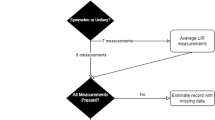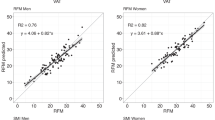Abstract
New developments in the field of technology have led to the use of scanners in order to obtain anthropometric measurements. As a matter of fact, anthropometry finds its roots in the seventeenth century, currently its usage has been strengthened by the employment of scanners. 3D whole-body scanners allow to collect reliable data and to visualise the exact human body shape. Thus, this paper aims at exploring the combination of these topics, anthropometry and scan, through an innovative tool, the scientometrics analysis. This technique provides a clear overview of the existing literature in the field investigated. In our study we examined 1’652 papers from the Web of Science Core Collection database. Network analyses have shown an interesting scenario, emphasising the research evolution over time. Specifically, endocrinology and metabolism emerged as the most active publication domains. Accordingly, the two most high-impact journals and the most cited paper regard nutrition issues and metabolic risk factors respectively. However, the predominance of the USA for number of publications has not been confirmed by the institution’s analysis, which has shown the University of Copenhagen as the most influential one. On the other hand, Yumei Zhang currently appears as the main authority in the field and Leslie G. Farkas as the most influential author over the entire time span analysed. The relevant implications of the findings are discussed in terms of future research lines.
Access this chapter
Tax calculation will be finalised at checkout
Purchases are for personal use only
Similar content being viewed by others
References
Utkualp, N., Ercan, I.: Anthropometric measurements usage in medical sciences. Biomed. Res. Int. 2015, 7 (2015)
Breno, M., Leirs, H., Van Dongen, S.: Traditional and geometric morphometrics for studying skull morphology during growth in Mastomys natalensis (Rodentia: Muridae). J. Mammal. 92(6), 1395–1406 (2011)
Madden, A.M., Smith, S.: Body composition and morphological assessment of nutritional status in adults: a review of anthropometric variables. J. Hum. Nutr. Dietietics 29, 1–19 (2014)
Heymsfield, S.B., et al.: Digital anthropometry: a critical review. Eur. J. Clin. Nutr. 72, 680–687 (2018)
Pedroli, E., et al.: The use of 3D body scanner in medicine and psychology: a narrative review. In: Cipresso, P., Serino, S., Ostrovsky, Y., Baker, Justin T. (eds.) MindCare 2018. LNICST, vol. 253, pp. 74–83. Springer, Cham (2018). https://doi.org/10.1007/978-3-030-01093-5_10
Mölbert, S.C., et al.: Assessing body image in anorexia nervosa using biometric self-avatars in virtual reality: attitudinal components rather than visual body size estimation are distorted. Psycholol. Med. 73, 38–46 (2018)
Cornelissen, K.K., et al.: Body size estimation in women with anorexia nervosa and healthy controls using 3D avatars. Sci. Rep. 17, 15773 (2017)
Wells, J.C.K., Ruto, A., Treleaven, P.: Whole-body three-dimensional photonic scanning: a new technique for obesity research and clinical practice. Int. J. Obes. 32, 232–238 (2008)
Ng, B.K., et al.: Clinical anthropometrics and body composition from 3D whole-body surface scans. Eur. J. Clin. Nutr. 70, 1265 (2016)
Haleem, A., Javaid, M.: 3D scanning applications in medical field: a literature-based review. Clin. Epidemiol. Glob. Health 7, 199–210 (2018)
Pleuss, J.D., et al.: A machine learning approach relating 3D body scans to body composition in humans. Eur. J. Clin. Nutr. (2018)
Chen, C.: CiteSpace II: detecting and visualizing emerging trends and transient patterns in scientific literature. J. Am. Soc. Inf. Sci. Technol. 57(3), 359–377 (2006)
Brandes, U.: A faster algorithm for betweenness centrality. J. Math. Sociol. 25(2), 163–177 (2001)
Freeman, L.C.: A set of measures of centrality based on betweenness. Sociometry 40(1), 35 (1977)
Kleinberg, J.: Bursty and hierarchical structure in streams. Data Min. Knowl. Discov. 7(4), 373–397 (2003)
González-Teruel, A., González-Alcaide, G., Barrios, M., Abad-García, M.F.: Mapping recent information behavior research: an analysis of co-authorship and co-citation networks. Scientometrics 103(2), 687–705 (2015)
Orosz, K., Farkas, L.J., Pollner, P.: Quantifying the changing role of past publications. Scientometrics 108(2), 829–853 (2016)
Small, H.: Co-citation in the scientific literature: a new measure of the relationship between two documents. J. Am. Soc. Inf. Sci. 24(4), 265–269 (1973)
Bu, Y., Liu, T.Y., Huang, W.B.: MACA: a modified author co-citation analysis method combined with general descriptive metadata of citations. Scientometrics 108(1), 143–166 (2016)
White, H.D., Griffith, B.C.: Author cocitation: a literature measure of intellectual structure. J. Am. Soc. Inf. Sci. 32(3), 163–171 (1981)
Ulijaszek, T.J. Lourie, J.A.: Intra- and inter-observer error in anthropometric measurement. Anthropometry, pp. 30–55
Madden, A.M., Smith, S.: Body composition and morphological assessment of nutritional status in adults: a review of anthropometric variables. J. Hum. Nutr. Diet. 29(1), 7–25 (2016)
Cole, T.J., Bellizzi, M.C., Flegal, K.M., Dietz, W.H.: Establishing a standard definition for child overweight and obesity worldwide: international survey. BMJ 320(7244), 1240–1243 (2000)
Yusuf, S., et al.: Obesity and the risk of myocardial infarction in 27 000 participants from 52 countries: a case-control study. Lancet 366(9497), 1640–1649 (2005)
Kahn, H.S., Austin, H., Williamson, D.F., Arensberg, D.: Simple anthropometric indices associated with ischemic heart disease. J. Clin. Epidemiol. 49(9), 1017–1024 (1996)
Treleaven, P., Wells, J.: 3D Body scanning and healthcare applications. Computer 40(7), 28–34 (2007)
Tzou, C.-H.J., et al.: Comparison of three-dimensional surface-imaging systems. J. Plast. Reconstr. Aesthet. Surg. 67(4), 489–497 (2014)
Weinberg, S.M., Naidoo, S., Govier, D.P., Martin, R.A., Kane, A.A., Marazita, M.L.: Anthropometric precision and accuracy of digital three-dimensional photogrammetry: comparing the Genex and 3dMD imaging systems with one another and with direct anthropometry. J. Craniofac. Surg. 17(3), 477–483 (2006)
Haarbo, J., Gotfredsen, A., Hassager, C., Christiansen, C.: Validation of body composition by dual energy X-ray absorptiometry (DEXA). Clin. Physiol. 11(4), 331–341 (1991)
Jensen, S.M., Mølgaard, C., Ejlerskov, K.T., Christensen, L.B., Michaelsen, K.F., Briend, A.: Validity of anthropometric measurements to assess body composition, including muscle mass, in 3-year-old children from the SKOT cohort. Matern. Child Nutr. 11(3), 398–408 (2015)
Yu, K., Xue, Y., He, T., Guan, L., Zhao, A., Zhang, Y.: Association of spicy food consumption frequency with serum lipid profiles in older people in China. J. Nutr. Health Aging 22(3), 311–320 (2018)
Zhao, A., et al.: Knowledge, attitude, and practice (KAP) of dairy products in Chinese urban population and the effects on dairy intake quality. Nutrients 9(7), 668 (2017)
Ferrario, V.F., Sforza, C., Zanotti, G., Tartaglia, G.M.: Maximal bite forces in healthy young adults as predicted by surface electromyography. J. Dent. 32(6), 451–457 (2004)
Sforza, C., de Menezes, M., Ferrario, V.: Soft- and hard-tissue facial anthropometry in three dimensions: what’s new. J. Anthropol. Sci. 91, 159–184 (2013)
Farkas, L.G., Eiben, O.G., Sivkov, S., Tompson, B., Katic, M.J., Forrest, C.R.: Anthropometric measurements of the facial framework in adulthood: age-related changes in eight age categories in 600 healthy white North Americans of European ancestry from 16 to 90 years of age. J. Craniofac. Surg. 15(2), 288–298 (2004)
Farkas, L.G., Katic, M.J., Forrest, C.R.: International anthropometric study of facial morphology in various ethnic groups/races. J. Craniofacial Surg. 16(4), 615–646 (2005)
Robinette, K.M., Daanen, H., Paquet, E.: The CAESAR project: a 3-D surface anthropometry survey. In: Second International Conference on 3-D Digital Imaging and Modeling (Cat. No. PR00062), pp. 380–386. IEEE (1999)
Fox, C.S., et al.: Abdominal visceral and subcutaneous adipose tissue compartments: association with metabolic risk factors in the Framingham Heart Study. Circulation 116(1), 39–48 (2007)
Ball, R., Shu, C., Xi, P., Rioux, M., Luximon, Y., Molenbroek, J.: A comparison between Chinese and Caucasian head shapes. Appl. Ergon. 41(6), 832–839 (2010)
Daanen, H.A.M., Ter Haar, F.B.: 3D whole body scanners revisited. Displays 34(4), 270–275 (2013)
Daanen, H.M., van de Water, G.J.: Whole body scanners. Displays 19(3), 111–120 (1998)
Acknowledgments
The present work was supported by the European funded project “Body-Pass”-API-ecosystem for cross-sectional exchange of 3D personal data (H2020-779780).
Author information
Authors and Affiliations
Corresponding author
Editor information
Editors and Affiliations
Rights and permissions
Copyright information
© 2019 ICST Institute for Computer Sciences, Social Informatics and Telecommunications Engineering
About this paper
Cite this paper
Toti, M., Tuena, C., Semonella, M., Pedroli, E., Riva, G., Cipresso, P. (2019). Anthropometry and Scan: A Computational Exploration on Measuring and Imaging. In: Cipresso, P., Serino, S., Villani, D. (eds) Pervasive Computing Paradigms for Mental Health. MindCare 2019. Lecture Notes of the Institute for Computer Sciences, Social Informatics and Telecommunications Engineering, vol 288. Springer, Cham. https://doi.org/10.1007/978-3-030-25872-6_8
Download citation
DOI: https://doi.org/10.1007/978-3-030-25872-6_8
Published:
Publisher Name: Springer, Cham
Print ISBN: 978-3-030-25871-9
Online ISBN: 978-3-030-25872-6
eBook Packages: Computer ScienceComputer Science (R0)




